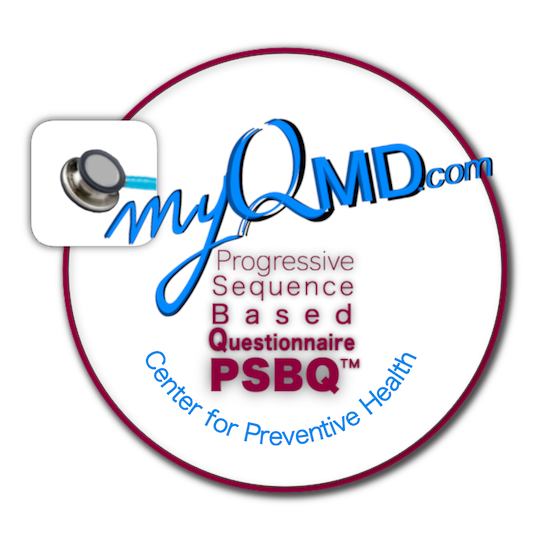Contact Us
If you have any questions, please do not hesitate to reach out to us.
Email us at: admin@myqmd.com

If you have any questions, please do not hesitate to reach out to us.
Email us at: admin@myqmd.com














Progressive Sequence Based Questionnaire TM
These are multiple choice answers to preventive health questions in a progressive format that helps analyze the cause, symptoms, possible diagnosis including risk factors and recommendations of various diseases. It should be noted that this website does not get involved in the diagnosis of diseases, but provides referral to physicians and healthcare providers including hyperlinks to professional medical sites. In compliance with international healthcare guidelines, we have limitations in providing complete information regarding any disease entity.
PSBQ TM
[Progressive Sequence Based Questionnaire]
Tackling Longevity Together
This preview is for familiarization of the process of PSBQ.
The chosen captions are for example only and are not in lieu of the original content.
Disclaimer: No claim is made to the exclusive right to use PROGRESSIVE SEQUENCE BASED QUESTIONNAIRE apart from the mark as shown.
Progressive Sequence Based Questionnaire TM
These are multiple choice answers to preventive health questions in a progressive format that helps analyze the cause, symptoms, possible diagnosis including risk factors and recommendations of various diseases. It should be noted that this website does not get involved in the diagnosis of diseases, but provides referral to physicians and healthcare providers including hyperlinks to professional medical sites. In compliance with international healthcare guidelines, we have limitations in providing complete information regarding any disease entity.



















Disclaimer: No claim is made to the exclusive right to use PROGRESSIVE SEQUENCE BASED QUESTIONNAIRE apart from the mark as shown.
Progressive Sequence Based Questionnaire TM
These are multiple choice answers to preventive health questions in a progressive format that helps analyze the cause, symptoms, possible diagnosis including risk factors and recommendations of various diseases. It should be noted that this website does not get involved in the diagnosis of diseases, but provides referral to physicians and healthcare providers including hyperlinks to professional medical sites. In compliance with international healthcare guidelines, we have limitations in providing complete information regarding any disease entity.
Disclaimer: No claim is made to the exclusive right to use PROGRESSIVE SEQUENCE BASED QUESTIONNAIRE apart from the mark as shown.
Disclaimer: All the health index scores referred to in this website were developed to help you gain better understanding of your health relative to preventive health information provided herein. Where in doubt, your health care provider takes precedence over recommendations derived from this website.
Based upon currently used inflammation score, cardiac risk factors, international prostate symptom score, pain scale etc, we have developed AI-based* questionnaire (PSBQ TM) that will enhance your basic understanding of the information provided by myqmd.com.
Please be informed that following questionnaire is adapted from PHQ* for headache and psychological conditions; Vision Screening/Visual Aquity/Photoscreening for eyes; TSH* for thyroid; PTH* for Parathyroid; Peak Flow/PFT* for lungs; Mammography for breast; EKG*, Coronary Calcium Score, Cardiac Enzymes, Echo, Exercise Stress Test, Cholesterol Screening for heart; H Pylori* for stomach; FBS*, A1C* and GTT* for metabolic diseases; Fractionated Amylase for pancreas; Pap Smear for Cervix; PSA* for Prostate; DRE*, FOBT* and Colonoscopy (Conventional or Virtual) for colon. The screening tools are not limited to the previously listed but when the need arises and further research studies are obtained, then our team will update the list to reflect the new advances. Most of the screening tools are found to be age-dependent.
Click here if you are ready to upload personal health information to HIPAA-compliant database.
VISUAL ACUITY IN OLDER ADULTS:
USPSTF. impaired visual acuity in older adults: screening. 2016.*
© 2025 · COR Medical Enterprises, LLC Center for Preventive Health
